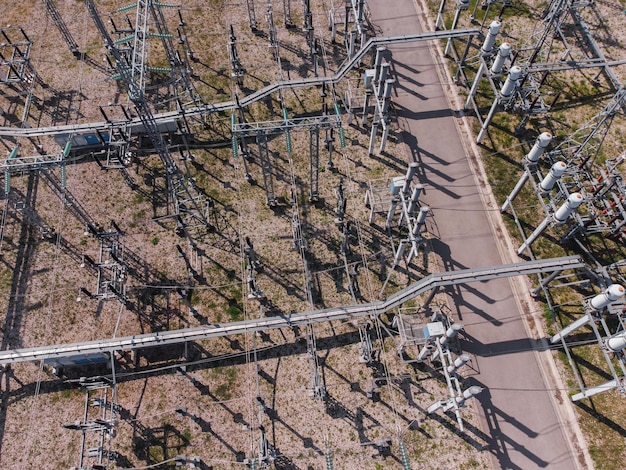Mexico’s Energy Sector Reform: Implications for US Energy Markets

Mexico’s recent energy sector reforms signify a critical shift that directly impacts the stability and future trajectories of the United States’ energy markets, particularly concerning cross-border energy trade, investment in renewables, and supply chain resilience.
The intricate relationship between the United States and Mexico extends far beyond shared borders, deeply intertwining economies, cultures, and, significantly, energy landscapes. The recent reforms in
understanding Mexico’s reform journey
Mexico’s energy sector has undergone significant transformations, oscillating between periods of state control and market liberalization. Since the expropriation of foreign oil interests in 1938, the sector has largely been dominated by state-owned enterprises like Pemex (Petróleos Mexicanos) for oil and gas, and CFE (Comisión Federal de Electricidad) for electricity. These entities, while central to national identity and development, often faced challenges related to efficiency, investment, and technological advancement.
The 2013-2014 energy reforms under then-President Enrique Peña Nieto marked a pivotal moment. These reforms aimed to open the energy sector to private and foreign investment, modernize infrastructure, increase competition, and boost production. The objective was to stimulate economic growth, reduce energy costs, and enhance the country’s energy security through greater efficiency and diversified investments. This period saw a surge in interest from international companies, including many from the US, eager to participate in Mexico’s vast energy potential, particularly in deepwater oil exploration, shale gas development, and renewable energy projects. However, the subsequent administration has altered this trajectory significantly.
shifting policy landscape under AMLO
The current administration of President Andrés Manuel López Obrador (AMLO) has largely pursued a policy of re-nationalization and strengthening state control over the energy sector. This shift is rooted in a nationalist vision, aiming to restore the prominence of Pemex and CFE and reduce reliance on private and foreign entities. The rationale often cited includes energy sovereignty, ensuring affordable energy for citizens, and protecting national resources from what is perceived as excessive foreign influence. This policy pivot has manifested in several legislative and regulatory changes:
- Prioritizing State-Owned Companies: New regulations often favor Pemex and CFE in tenders, permitting processes, and dispatch order for electricity generation.
- Revisiting Contracts: Some existing contracts with private companies have been reviewed, renegotiated, or, in some cases, challenged, creating an environment of uncertainty for investors.
- Regulatory Changes: Amendments to energy laws and regulations have sought to limit private participation in areas previously opened, particularly in renewable energy and fuel imports.
These policy shifts have generated considerable concern among private investors and international partners, including the United States, raising questions about legal certainty and the long-term viability of private energy projects in Mexico. The emphasis on strengthening state enterprises, while appealing to a nationalist sentiment, has inadvertently led to increased operational and financial strain on these companies, further complicating the energy outlook.
The journey of Mexico’s energy sector reform, therefore, is not linear but cyclical, reflecting deeper ideological and economic currents. Understanding this complex history and the current policy environment is fundamental to assessing the implications for its most vital energy partner, the United States.
impact on US energy exports and imports
The energy relationship between the United States and Mexico is multifaceted, encompassing significant flows of natural gas, refined products, and electricity. Both nations are deeply interdependent, with energy infrastructure like pipelines and transmission lines crisscrossing the border, facilitating a seamless regional energy market. Recent reforms in Mexico’s energy sector have introduced new variables into this delicate balance, prompting reevaluation of supply chains and investment strategies for US energy companies.
natural gas trade dynamics
The United States is the primary supplier of natural gas to Mexico, largely due to ample shale gas production and a well-developed pipeline network connecting key production basins in Texas to Mexican demand centers. This trade has been mutually beneficial: US producers find a strong export market, while Mexico secures a reliable and often more affordable fuel source for its power generation and industrial sectors. However, recent Mexican energy policies, emphasizing CFE’s role and potentially limiting new private pipeline development, could influence this dynamic. While existing contracts ensure a baseline level of trade, future growth opportunities for US gas exports might face constraints if Mexico’s energy mix moves away from gas in favor of state-owned generation, or if regulatory hurdles increase for private off-takers and developers.
The reliability of natural gas supply is crucial for Mexico, particularly given its increasing reliance on gas-fired power plants. Any disruption or policy-induced shift that affects this supply could have tangible impacts on Mexico’s energy sovereignty and, by extension, on the economic stability of regions heavily dependent on US natural gas. For example, the Texas winter storm in 2021, which interrupted gas flows to Mexico, highlighted the vulnerabilities of this interdependence. Mexico’s subsequent push for greater energy independence, while understandable from a national security perspective, might lead to decisions that affect the economic viability of cross-border gas infrastructure projects.
refined products and cross-border infrastructure
Mexico is a significant importer of gasoline and other refined products from the US, as its domestic refining capacity is insufficient to meet demand. US refineries, particularly those along the Gulf Coast, are well-positioned to serve this market. However, Mexico’s current administration has expressed a strong desire to achieve “energy self-sufficiency” through rehabilitation of existing refineries and construction of new ones, such as the Dos Bocas refinery. If successful, this initiative could reduce Mexico’s reliance on US refined product imports. This would, in turn, affect the profitability and utilization rates of some US refineries built to leverage these export opportunities.
Furthermore, the development of cross-border infrastructure, including pipelines for refined products, has been critical for this trade. Lingering policy uncertainty and regulatory changes in Mexico could deter future private investment in such infrastructure, potentially leading to bottlenecks or increased logistical costs. For US energy companies, this translates into a need for careful risk assessment when considering new investments in cross-border distribution or expansion of existing facilities that rely heavily on the Mexican market.
Overall, the implications for US energy exports and imports are complex. While established trade relationships provide a certain level of stability, the reform narrative in Mexico suggests a potential pivot towards greater self-reliance and state control. This shift necessitates US energy producers and infrastructure developers to closely monitor policy developments and adapt their strategies to a changing Mexican energy landscape.
implications for US investment in Mexico’s energy sector
Before the current wave of reforms, Mexico presented an attractive frontier for US energy investors. The 2013-2014 energy reforms had opened up vast opportunities across the entire energy value chain, from upstream oil and gas exploration to power generation, transmission, and fuel distribution. US companies, leveraging their technological expertise, capital, and proximity, were poised to be major players in modernizing Mexico’s energy infrastructure and unlocking its vast potential.

the chilling effect on foreign direct investment
The policy shifts initiated by the current Mexican administration, which prioritize state control and often modify or delay existing agreements, have created an environment of uncertainty for foreign direct investment (FDI). Investors thrive on predictability, legal certainty, and a transparent regulatory framework. When these elements are compromised:
- Risk Premia Increase: The perceived risk of doing business in Mexico rises, demanding higher returns to compensate for potential policy U-turns, regulatory changes, or arbitrary contract cancellations.
- Delayed or Cancelled Projects: New projects are often put on hold or cancelled outright due to concerns about their long-term viability and profitability under the new rules of engagement. This is particularly evident in the renewable energy sector, where private developers have faced significant hurdles.
- Reduced Investor Appetite: Overall investor appetite for Mexican energy projects diminishes, as capital seeks more stable and predictable markets elsewhere. This can lead to a long-term drain on potential investment, hindering Mexico’s own energy development goals.
Many US companies that had invested in Mexico’s energy sector since the 2014 reforms now face challenges. These include delays in permits, changes in dispatch rules that favor CFE’s less efficient plants, and a general tightening of the regulatory environment. This not only impacts the profitability of their existing operations but also casts a shadow over any future expansion plans.
sector-specific impacts: renewables and fossil fuels
The impact of Mexico’s energy reforms is not uniformly distributed across all segments of the energy sector:
- Renewables: The renewable energy sector, which saw substantial US and international investment post-2014, has been particularly hit. Policies favoring CFE’s aging fossil fuel plants over more efficient and cheaper private renewable projects (through changes in dispatch rules and grid access) undermine the economic viability of clean energy investments. This is a significant concern for US companies committed to sustainable energy development and for the broader global climate agenda.
- Fossil Fuels (Upstream and Downstream): In the upstream oil and gas sector, while existing contracts are generally being honored, new exploration and production blocks are no longer being offered to private companies. The emphasis is on Pemex increasing its own production. In the downstream sector (refining and fuel sales), private players face increased competition from state-owned entities often operating with preferential treatment, further deterring new investment.
The cumulative effect of these policies is a significant reduction in US investment in Mexico’s energy matrix. This not only impacts Mexico’s ability to attract the capital and technology needed for its energy future but also limits opportunities for US companies. It also raises concerns about regional competitiveness, as other Latin American countries may present more appealing investment climates for energy development.
geopolitical and regional energy stability
The energy relationship between the United States and Mexico is not merely transactional; it is a critical component of regional geopolitical stability. Energy security for both nations is deeply intertwined, making disruptions in one country reverberate across the border. Mexico’s energy sector reforms, particularly those emphasizing state control and potential trade barriers, pose significant questions for the long-term energy stability of North America.
USMCA and trade disputes
The United States-Mexico-Canada Agreement (USMCA), which replaced NAFTA, provides a framework for trade and investment between the three nations. Energy is a crucial component of this agreement, with provisions designed to ensure open markets and fair competition. Mexico’s recent energy policies have, however, raised concerns about their compatibility with USMCA obligations. The US and Canada have initiated dispute settlement consultations under the USMCA, alleging that Mexico’s policies discriminate against foreign companies in favor of its state-owned enterprises, particularly in the electricity sector. Key issues include:
- Preference for CFE and Pemex: Policies that give CFE and Pemex an unfair advantage over private companies regarding dispatch, access to infrastructure, and permitting.
- Restrictions on Renewable Energy: Measures that effectively block new private renewable energy projects or make existing ones unviable.
- Uncertainty for Investors: Lack of legal certainty and predictability for long-term investments made by US and Canadian companies.
These disputes underscore the potential for trade tensions to spill over into broader diplomatic relations. A resolution to these disputes, either through negotiation or formal arbitration, will be critical in determining the future predictability of the US-Mexico energy trade relationship. A prolonged dispute could erode trust and hinder future collaborative efforts on energy security.
The integrity of USMCA’s energy provisions is vital for maintaining the integrated North American energy market. Any perceived undermining of these provisions could set a precedent that affects other sectors and future trade agreements, making this a high-stakes issue for both Washington and Mexico City.
regional energy security and climate goals
Beyond trade, the US and Mexico share a common stake in regional energy security and addressing climate change. Mexico’s energy choices directly influence North American energy resilience. For example, reliable access to natural gas from the US enhances Mexico’s energy security, particularly during peak demand or unexpected disruptions. Conversely, a stable and predictable energy sector in Mexico contributes to the overall stability of regional energy supply chains.
However, the emphasis on strengthening fossil fuel-dependent state entities (Pemex and CFE) at the expense of renewable energy development raises concerns about Mexico’s and, by extension, North America’s ability to meet ambitious climate goals. The US has publicly committed to significant emissions reductions, and Mexico’s trajectory can either support or hinder these regional efforts. Investing in and promoting renewable energy sources, cross-border carbon capture technologies, and grid modernization are essential steps for both nations to collaboratively address climate change. A divergence in energy policy where Mexico prioritizes fossil fuels while the US pushes for rapid decarbonization creates a rift in what should be a unified front against climate change.
In essence, the geopolitical implications extend beyond immediate economic losses. They touch upon the core principles of free trade, the stability of a deeply integrated regional energy market, and the collective ability to combat climate change, requiring careful diplomatic engagement and long-term strategic planning from both sides.
environmental and sustainability considerations
Mexico’s energy policies have profound implications not only for economic and geopolitical landscapes but also for environmental sustainability, particularly concerning greenhouse gas emissions and the expansion of renewable energy. The United States, having committed to ambitious climate goals, watches Mexico’s energy transition with keen interest, as collective action is crucial for regional and global environmental health.
the trajectory of renewable energy development
The 2013-2014 reforms had catalyzed significant private investment in renewable energy in Mexico, leading to a substantial increase in solar and wind capacity. This was seen as a positive step towards diversifying Mexico’s energy matrix and reducing its carbon footprint. However, the current administration’s emphasis on strengthening CFE and Pemex, coupled with restrictive policies towards private renewable energy projects, has slowed this progress considerably. For instance, changes in grid dispatch rules have prioritized electricity generated by CFE’s fossil fuel plants (which are often older and less efficient) over cleaner and cheaper electricity from private wind and solar farms. This effectively makes new renewable projects less financially attractive or even unviable.
This slowdown in renewable energy development in Mexico has several environmental consequences:
- Increased Reliance on Fossil Fuels: By favoring state-owned fossil fuel plants, Mexico risks prolonging its dependence on petroleum and coal, leading to higher greenhouse gas emissions.
- Missed Emission Reduction Targets: The country might struggle to meet its nationally determined contributions (NDCs) under the Paris Agreement, which outlines its commitments to reduce emissions.
- Reduced Clean Energy Investment: The uncertainty discourages further US and international investment in Mexico’s clean energy sector, hindering its potential to become a significant regional producer of renewable energy.
For the US, which aims for a carbon-free electricity sector by 2035, the trajectory of Mexico’s energy transition is relevant. A vibrant renewable energy sector in Mexico could offer opportunities for cross-border clean energy trade and shared technological advancements. Conversely, a policy path that entrenches fossil fuels works against regional efforts to combat climate change.
cross-border pollution and environmental standards
Beyond greenhouse gases, Mexico’s energy policies can influence local air and water quality, which often have cross-border implications. For example, increased reliance on older, dirtier fossil fuel plants in Mexico could contribute to transboundary air pollution, affecting communities along the US-Mexico border. Similarly, environmental standards for new industrial projects or the operation of existing facilities (e.g., refineries or power plants) can affect shared ecosystems and resource management, such as water basins.
US environmental policies and agencies often work with their Mexican counterparts on issues of shared environmental concern. However, if Mexico’s regulatory framework weakens or its enforcement capabilities are stretched in favor of rapid state-led development, it could strain these cooperative efforts. Maintaining robust environmental standards and fostering sustainable practices in the energy sector is not only an internal matter for Mexico but a shared concern for North America. Collaborative efforts on environmental protection, technological transfer for cleaner energy production, and the adoption of best practices are crucial for the long-term well-being of both nations.
Ultimately, Mexico’s energy strategy plays a significant role in determining the regional pace of climate action and environmental protection. A sustainable energy future for North America requires not just economic cooperation but also a shared commitment to environmental stewardship and a transition towards cleaner energy sources.
strategic considerations for US energy companies
The evolving energy landscape in Mexico presents a complex set of challenges and opportunities for US energy companies operating or contemplating investments in the region. Navigating this environment requires a nuanced understanding of policy shifts, risk mitigation strategies, and adapting business models to new realities. Success will hinge on agility, robust risk assessment, and a willingness to engage constructively with Mexican stakeholders.
adapting investment and operational strategies
US energy companies must consider several strategic adjustments:
- Enhanced Due Diligence: Before any new investment, conducting enhanced due diligence is paramount. This goes beyond financial analysis to include thorough assessments of the political and regulatory environment, legal certainty, and the specific risks associated with state intervention or policy changes. Understanding the current administration’s priorities and the potential for future shifts is key.
- Diversification of Portfolio: For companies with significant exposure to the Mexican energy sector, diversifying their investment portfolio across different regions or energy segments can mitigate risks. Reducing over-reliance on a single market or specific policy framework becomes essential.
- Focus on Niche Opportunities: While large-scale public-private partnerships might face increased scrutiny, niche opportunities could still exist. These might include specialized services, technology provision, or projects that align with government priorities (e.g., specific infrastructure upgrades for Pemex or CFE, or projects that directly support local communities).
- Strong Local Partnerships: Building strong relationships with local Mexican partners, who possess deep knowledge of the regulatory landscape and political dynamics, can be invaluable. These partnerships can help navigate complexities and identify viable pathways for investment.
- Emphasis on Sustainability and ESG: Embracing and promoting strong Environmental, Social, and Governance (ESG) practices can differentiate companies. Projects with clear sustainability benefits might find more favorable reception, especially if they align with Mexico’s broader development goals beyond pure energy production.
Flexibility in contract negotiation and a willingness to collaborate within the new framework are also crucial. Companies may need to explore different contracting models or develop projects that minimize direct competition with state-owned entities.
engaging with stakeholders and advocating for open markets
Beyond individual company strategies, collective engagement and advocacy are vital. US energy companies and industry associations should:
- Maintain Dialogue with Mexican Government: Continue open and constructive dialogue with relevant Mexican government agencies, explaining the benefits of foreign investment, technology transfer, and market competition for Mexico’s energy future. This involves presenting clear, data-driven arguments on how stable policies attract capital and contribute to energy security and economic growth.
- Work with US Government: Collaborate closely with the US government, including the Department of State, Department of Energy, and trade representatives, to articulate concerns, seek support for fair trade practices under USMCA, and explore diplomatic avenues for resolving disputes.
- Support Rule of Law: Advocate for the consistent application of the rule of law and respect for existing contracts. Legal certainty is the cornerstone of a healthy investment climate, and ensuring contractual obligations are upheld is critical for investor confidence.
- Public Education: Engage in public education campaigns in both the US and Mexico to highlight the benefits of cross-border energy cooperation, secure energy supplies, and the role of private investment in achieving energy goals. Countering misinformation and building public understanding can be a long-term strategy to foster a more favorable investment climate.
Mexico’s energy sector represents a significant opportunity, but it is one that now comes with a heightened degree of political and regulatory risk. US energy companies willing to adapt, engage strategically, and prioritize long-term relationships will be best positioned to navigate these complexities and find success in this evolving market.
future outlook and scenarios
The future of Mexico’s energy sector and its implications for US energy markets are subject to a range of variables, including political transitions, global energy price fluctuations, and the accelerating pace of energy transition technologies. Predicting the exact trajectory is challenging, but several scenarios offer a glimpse into potential futures, each with distinct consequences for the bilateral energy relationship.
scenario 1: continued state control with gradual adjustments
In this scenario, the current emphasis on state control, particularly through Pemex and CFE, largely continues. While there might be some incremental adjustments to address operational inefficiencies or specific complaints from investors, the overarching policy goal remains energy sovereignty via state-owned enterprises. New private investment opportunities remain limited, especially in generation and upstream exploration, and regulatory hurdles persist.
- Implications for US: Limited growth in US energy exports to Mexico beyond existing contracts. Reduced new US investment in Mexican energy. Ongoing, but possibly low-intensity, trade disputes under USMCA. Regional energy integration slows or stalls.
- Mexico’s Outlook: Continued financial strain on Pemex and CFE. Potential for slower energy infrastructure development and higher energy costs if state entities cannot meet demand efficiently. Slower progress on renewable energy adoption.
This scenario suggests a plateauing of the energy relationship, with existing dependencies largely maintained but opportunities for deeper integration curtailed.
scenario 2: selective opening and pragmatic cooperation
This scenario envisions a more pragmatic approach from Mexico, possibly driven by economic necessity or a change in political leadership. While state entities retain a significant role, the government recognizes the need for private capital and technology to meet energy demands and modernize infrastructure. This could lead to selective openings for private investment in specific areas, perhaps in new technologies, non-core assets, or projects that clearly align with national priorities (e.g., grid modernization, specific renewable projects, or enhanced oil recovery). Cooperation with US energy companies might focus on shared energy security goals and cross-border infrastructure development, respecting the roles of both public and private sectors.
- Implications for US: Renewed, albeit cautious, interest in US investment opportunities. Potential for growth in specific energy exports (e.g., natural gas, specialized equipment). A more constructive dialogue on USMCA energy provisions. Enhanced regional energy security.
- Mexico’s Outlook: Improved access to capital and technology. Potential for more rapid development of energy infrastructure. Balanced progress on meeting energy demand and transitioning to cleaner sources.
This scenario represents a more optimistic outlook, balancing nationalistic aspirations with economic practicalities, fostering renewed collaboration.

scenario 3: significant policy reversal and market liberalization
This is the most optimistic, yet politically challenging, scenario. A future Mexican administration might opt for a significant reversal of current policies, moving back towards a more market-oriented framework akin to the 2013-2014 reforms. This would entail a renewed focus on attracting private and foreign investment across all energy sectors, streamlining regulations, and guaranteeing legal certainty for investors. Such a shift would likely be driven by economic pressures, a recognition of the inefficiencies of state monopolies, and a desire to accelerate energy transition.
- Implications for US: Substantial increase in US investment and participation across Mexico’s energy sector. Robust growth in cross-border energy trade. Stronger regional energy integration and security. Alignment on climate goals and accelerated renewable energy deployment.
- Mexico’s Outlook: Rapid modernization of the energy sector. Increased energy production, lower costs, and enhanced energy security. Significant progress towards clean energy targets. Higher economic growth driven by energy sector investment.
This scenario, while offering the greatest economic benefits for both nations, would require a substantial political and ideological shift within Mexico. Regardless of the scenario, the intricate dance between Mexico’s sovereignty ambitions and the practicalities of energy supply and demand will continue to define this vital bilateral relationship. US stakeholders must remain agile, informed, and prepared to adapt to an evolving energy partnership.
| Key Point | Brief Description |
|---|---|
| 📊 Policy Shift | Mexico’s current reforms favor state control (Pemex, CFE), moving away from earlier market liberalization. |
| 🛢️ Trade Impact | Potential constraints on US natural gas and refined product exports due to Mexico’s self-sufficiency goals. |
| 💰 Investment Climate | Increased uncertainty and regulatory hurdles deterring new US investments, especially in renewables. |
| 🌍 Regional Stability | USMCA disputes and divergence on climate goals impact North American energy integration and security. |
Frequently asked questions
Mexico’s current energy reforms primarily aim to strengthen state control over the energy sector, prioritizing state-owned companies like Pemex and CFE. The goals include achieving energy sovereignty, reducing reliance on foreign entities, and ensuring affordable energy supply for national consumers. This represents a significant shift from previous policies that encouraged private and foreign investment.
While existing natural gas contracts largely remain, Mexico’s reforms could limit future growth in US gas exports by favoring domestic state-owned generation. Any policy shifts that reduce reliance on gas-fired plants or increase regulatory hurdles for private sector gas usage might moderately impact volumes, though the US remains Mexico’s primary supplier.
US clean energy investments in Mexico have significantly slowed down due to restrictive policies. Changes in grid dispatch rules often favor CFE’s fossil fuel plants over private renewable projects, undermining their economic viability. This creates uncertainty for investors and hinders Mexico’s renewable energy development, impacting regional climate goals.
Yes, the US and Canada have initiated dispute settlement consultations under the USMCA. They allege that Mexico’s energy policies discriminate against foreign companies in favor of state-owned enterprises, particularly in the electricity sector. These disputes highlight concerns over legal certainty and fair competition for US and Canadian investors.
US energy companies should conduct enhanced due diligence, diversify portfolios, and focus on niche opportunities aligned with Mexico’s new priorities. Building strong local partnerships and engaging in constructive dialogue with both Mexican and US governments are crucial for navigating regulatory complexities and advocating for open markets and legal certainty.
conclusion
The reform within Mexico’s Energy Sector Reform: What Are the Implications for US Energy Markets? reverberates far beyond its borders, deeply influencing the intricate energy dynamics shared with the United States. While rooted in Mexico’s pursuit of energy sovereignty, these policy shifts introduce complexities that directly affect US energy exports, investment flows, regional energy security, and collective environmental goals. The evolving relationship necessitates continuous dialogue, strategic adaptation from US companies, and a recognition that the energy future of North America is inextricably linked. Navigating these changes effectively will require both nations to balance national interests with the imperative of shared prosperity and a sustainable energy transition.





